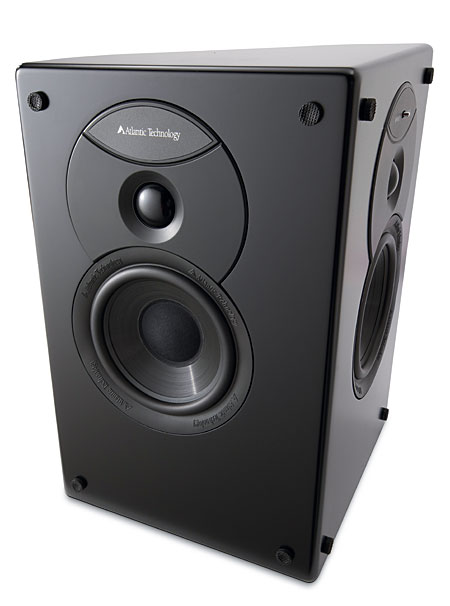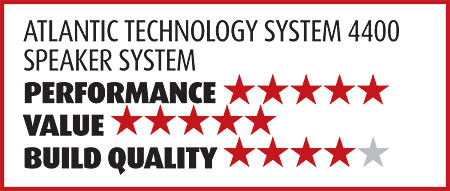Atlantic Technology System 4400 Speaker System Page 2

Associated equipment included the Rotel RSX-1550 A/V receiver, Panasonic DMP-BD35 Blu-ray player, Integra DPS-10.5 universal player, Luxman PD-289 turntable, Shure V97xE cartridge, and Bell- ari VP630 tubed phono preamp. All movie selections were Blu-rays.
Blasting, Barking, Screech and Boom
Once again, I got my action-movie fix from the Matrix series. This time, I chose The Matrix: Revolutions in Dolby TrueHD. Unlike the first two installments, the third film has a fairly reasonable dynamic range throughout the first half. Only in the second half does the aural mayhem escalate to the point where on-the-fly master volume adjustments are necessary.
To Atlantic Tech’s credit, the volume level I considered appropriate for vocals and the lower one I preferred for the loudest effects weren’t far apart. I attribute this partly to the center’s superb dialogue intelligibility, which is among the best I’ve heard, and partly to the tweeter’s avoidance of adding any sizzle of its own. The three front channels have same-sized but differently deployed drivers, and panning across these three speakers was also top notch. I wasn’t imprisoned in one position on the sofa. Also, the soundfield held together in a few thundery and rainy scenes. Note that I stuck with the factory-set bipole setting in the surrounds.
Marley & Me is a family comedy that’s propelled by three charm machines: Owen Wilson, Jennifer Aniston, and a succession of Labradors who take the title role from puppy to adult to senior citizen. Although it’s steadfastly conventional, the movie does develop its “world’s worst dog” concept into something with more emotional resonance as the plot unwinds. Marley, it turns out, hates thunder and becomes lavishly destructive every time it rumbles. But I enjoyed it—I could practically smell the rain. I would classify the DTS-HD Master Audio soundtrack as a B-lister (with limited TV-like dynamic range). However, R.E.M.’s “Shiny Happy People” was a stunner.
In The Grudge, here in Dolby TrueHD, Japanese director Takashi Shimizu wields an international cast in a predictable but jarring story of unhappy ghosts who reach forward from the past to terrify people in the present. The soundtrack design is pretty slick. It alternates near-silences with screech-and-boom attacks that were always well timed enough to make me jumpy. It has moments of quiet loveliness too, in the form of tremulous strings. Part of the mixer’s strategy was to keep the voices as low as possible so the effects would be all the more shocking. Here the 4400 C excelled—it consistently delivered the dialogue in sotto voce situations where many other centers would have fallen short. I got through this fairly dynamic soundtrack with one volume setting.
One and One and One Is Three
Robert Spano conducts the Atlanta Symphony Orchestra & Choruses in Telarc’s Transmigration, a multichannel SACD. This adroit bit of programming sand-
wiches three new works between two well-known older ones. The latter include Samuel Barber’s “Adagio for Strings” and its choral companion piece, “Agnus Dei,” which uses the same thematic material as the setting for a Latin prayer. Three new works include John Corigliano’s “Elegy” and Jennifer Higdon’s “Dooryard Bloom,” a setting of Walt Whit-
man’s poem mourning the assassination of President Lincoln. Both are beautiful, but the ambitious centerpiece is John Adams’ “On the Transmigration of Souls,” which explores the bittersweet memories of those who lost loved ones on September 11.

The Adams piece kept the soundfield busy with wandering footsteps and spoken-word material, which includes the names of 9/11 victims. Panning was crucial, and the Atlantic Techs didn’t miss a movement. A ghostly chorus, quiet at first, was luminously lovely and well resolved despite its low level. As the 23-minute work develops, crescendos arrived, with clangorous bells and brass that were fully developed and thrilling. Mounting dissonance was neither sugar-coated nor excruciating. In the other works, the Barber “Adagio” string sound was both strongly outlined and fully fleshed out. The baritone in the Higdon selection was vibrant, even at an initially low level. And the chorus in the second Barber was both detailed and well blended. The Atlantic Techs delivered versatile and impressive performance. They mined the high-resolution 5.1-channel recording for all of its considerable drama and texture, but they didn’t hype or overemphasize any particular element.
The Big Apple Bash by Jay McShann showcases the pianist, singer, and Kansas City jazz legend in a 1978 studio LP. The large ensemble includes Herbie Mann, Gerry Mulligan, Eddie Gomez, and others. Guitarist John Scofield emerged as the MVP. He was typically crisp and incisive but also unusually responsive to the other band members—his playing conveys his delight at being there. The Dolby Pro Logic II Music mode was perfect for this reverb-light recording, and it certainly helped that the 4400 SR bipole didn’t draw undue attention to the surround effects. Instead, it added a little fullness to the main activity in the front channels. Reed instruments, including Mann’s tenor sax and clarinet, were a treat. They combined a holographic presence with just enough articulation of the mouthpiece to remind me of what it was like to play the clarinet (badly) with the vibrating reed between my lips.
I finally got some use out of the Hi Energy toggles with the Beatles’ Abbey Road, around the time of its 40th anniversary. Although I cling to the vinyl, Capitol pressed the Fab Four’s American LP releases on cow manure, so I rarely play them. Instead I turned to the original CD release, which has imperfections of its own. The upper mids and highs are a little hard, and this is one album I refuse to play any way but loud, so I toggled the tweeters down to their Minus setting. While this didn’t radically transform the character of the sound, it brought enough additional listening comfort to let the master volume go up a decibel or two. Moved, as ever, by the underrated brilliance of the rhythm section—including Ringo’s drum solo, the most tasteful rock drum solo of all time—I also dialed up the sub.
Again, the DPLII Music mode was the right choice, albeit a revisionist one. It de-emphasized the extreme isolation of instruments mixed solely into the left or right channels and pulled them slightly forward. Stereo, by comparison, was sterile. As side two (as I still think of it) drew to its lushly orchestrated close, the layering of voices, strings, drums, and guitar was as good as I’ve ever heard. This is truly one of the great moments in recorded rock, and the Atlantic Techs didn’t waste the opportunity. They rose to greatness.
Atlantic Technology’s System 4400 lends itself to superlatives. The price/performance ratio couldn’t be more favorable: This package is a stellar performer as well as a pretty unbeatable value. I feel guilty for writing such bland sentences because the experience of listening to these speakers was quite the reverse. I remember flinching at the horror movie, nodding my head to the rhythm of the jazz record, and being nailed to the couch by the 5.1-channel drama of the SACD. You could have a lot of fun with these speakers. You might even be moved.

- Log in or register to post comments




































































